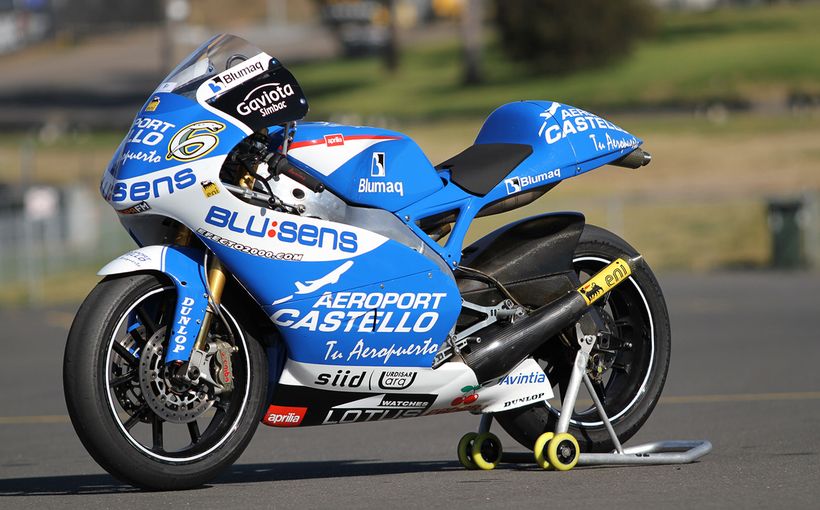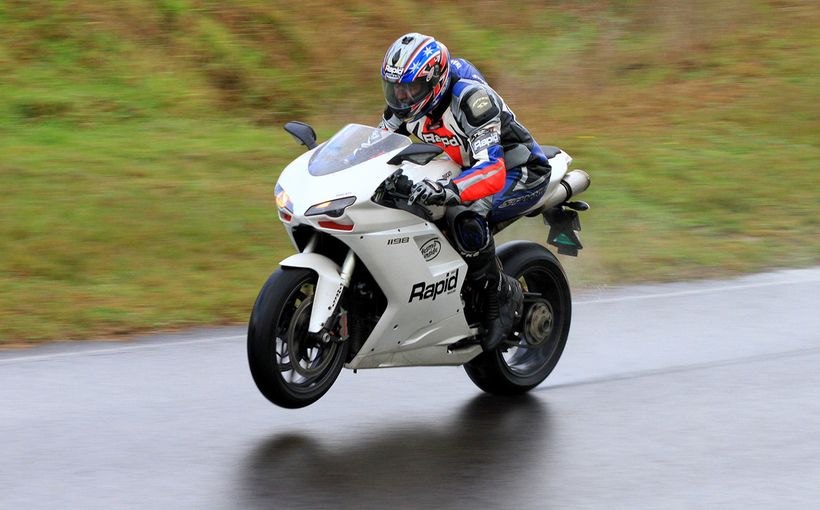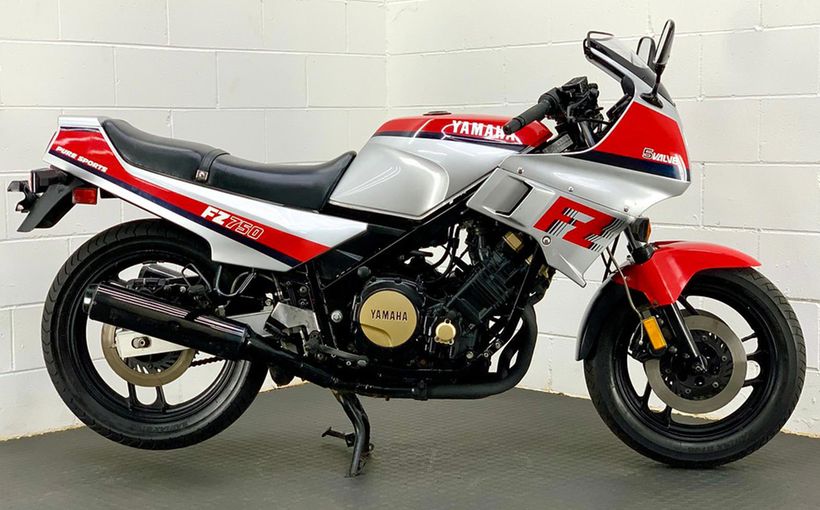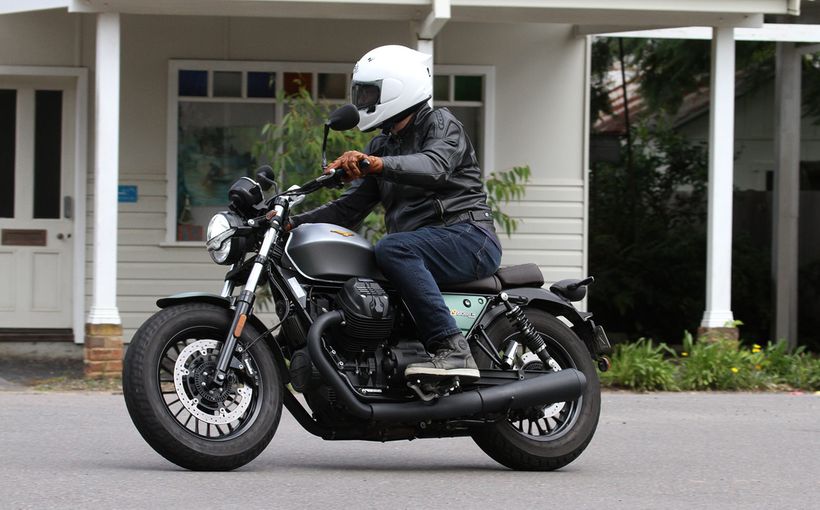Royal Enfield Interceptor & Continental GT 650: New World Order

Welcome to the New Millennium, the next generation, the New Testament, in the storied book of Royal Enfield. These all-new bikes, the Interceptor roadster and the Continental GT 650 cafe racer, with expected ride away prices of around $10,000 when they arrive early next year, represent the biggest turning point in the Indian-owned company’s 127-year history and certainly in its modern-day timeline.
This is where the sniggering, agricultural-likening and sympathetic excusing come to an abrupt end.
As the first multi-cylinder Royal Enfields in almost 50 years, the 650 twins are the first bikes born from the company’s new £3.5m technical centre in Leicestershire, UK. As such, they also represent Royal Enfield’s first global products aimed to penetrate western markets and lure a new wave of customers, driven by the new mantra of being simple, fun and accessible.
Then there are the millions of existing customers in India, many of whom can now afford to upgrade to a ‘big bike’ (a mid-capacity motorcycle to the rest of us). We’re talking about a country crammed with 1.3 billion people who are the world’s keenest bike buyers, with around 18 million sold each year, or more than 49,000 a day. For reference, Australians bought 104,111 last year, only slightly more than Indians buy in two days. The domestic market accounts for around 96 per cent of overall sales for Royal Enfield with overseas sales amounting to 75,000 or 80,000 units a month. The Interceptor and Continental GT 650 are therefore targeting increased exports as well as India’s increasingly affluent middle class. So you see, company ambitions for the all-new models are as gargantuan as they are global.

AUSSIE CONNECTION
Closer to home, we were confident these LAMS-approved bikes were going to be good without ever seeing them, let alone riding them. About two years ago, former AMCN road test editor Paul Young (pictured below) left our humble office to join Royal Enfield as a development rider, alongside many of his ex-Triumph colleagues at the Bruntingthorpe Proving Ground (which happens to be spitting distance from Triumph and Norton) in Leicestershire.
“One of the best parts of our job as test riders is we get to go out there and try and break everything,” Youngy said. “We try and make it do something wrong so we’ve got something to improve.”
When you’re talking about 140 gurus, doyens and masters in chassis and engine development, electronics and fuelling, the level of collective expertise guarantees limitless potential. Put it this way, if Royal Enfield’s parent company, Eicher Motors, decided to buy or revive another motorcycle brand, the guys at the UK tech centre have the skills and tools to conceive and deliver convincingly. Eicher almost bought Ducati... Royal Enfield is also building another tech centre, in India, five times larger than the UK facility.
So, to us, it was odds-on that these bikes were always going to be good, but the big question was how good. Specifically, to what extent would bureaucracy and cultural differences affect the final product? Could the Brits and the Indians come together to reach a common goal?
“It’s been a big project, and it’s gone through many, many stages,” chassis development engineer Chris Hunt says. “The biggest challenge was developing the motorcycle to meet the performance and quality levels that we wanted to achieve.” Or, as leading chassis engineer Ben Hine put it: “We weren’t willing to compromise on our goals.”
If that wasn’t tricky enough, the bikes are built to one specification for all markets, which means they need to please everybody. And that’s no piece of cake. Or gulab jamun. For instance, Indians have traditionally preferred a wooden feel for their front brake, which they don’t use anyway. They also need a powerful horn (two, actually, when one gives up); they rarely ride like we do in the western world, and they need robust suspension to withstand the weight of an entire family and abuse of bad roads.
There are also the high priorities and local laws we’d never consider, let alone have even heard of: a saree guard (yes, you read right) is mandatory on all two-seat motorcycles to protect loose and flowing clothes from tangling in the rear wheel.

A CLEAN-SHEET APPROACH
When it comes to motorcycle development (and now saree guards), Youngy, a former Triumph test rider and British Supersport champion with many years’ experience in race team ownership, is a picky sort of chap. So it was very much a case of actions speaking louder than words to see him there, quietly bursting with pride alongside the bikes, at their international launch in Santa Cruz, California, and spiritual home of the original Interceptor 750 of the early 1960s.
We cannot begin to imagine the highs, lows, meetings and teething problems that go into such a project across two continents. As a glimpse, towards the advanced stages of development, Youngy and his colleagues weren’t satisfied with the bikes’ high-speed stability characteristics and recommended moving the headstock back by 25mm. As with product development tests of any kind, the decision wasn’t taken lightly. “Youngy, are you absolutely sure, mate? It’s gonna be a hard convo to have with the Indians. You know it means scrapping more than a million quid’s worth of tooling, yeah?” “Yep. I’m sure.” The UK engineering team agreed the headstock change was indeed the solution and hoped for the best as they informed the top brass in Chennai. To Royal Enfield’s credit, however, management was fully supportive, no doubt driven by the company’s boss, Siddartha Lal, a passionate motorcyclist with a strong background in mechanical engineering (and economics).

Sid left it to the experts his team had poached, even if that meant dropping a mill and falling behind schedule. That’s how important the Interceptor and Continental GT 650 twins are to Royal Enfield, which will eventually be produced at a rate of 5000 units per day, or one bike every 52 seconds.
Such a churn rate may seem at odds with maintaining a consistent level of build quality, but the twins are the first models born from all-new design and manufacturing processes – CAD, CNC machining, robotic welding and painting as well as more stringent validation processes – which take place across three production plants in India.
The Interceptor and Continental GT 650s are indeed good-looking, well presented bikes with lovely attention to detail, and our test fleet demonstrated considerably higher fit and finish than Enfield’s existing models. And that’s despite our rides being pre-production bikes that were said to be 99 per cent production ready (the welds near the finned exhaust clamps are slated for revision, for example, and the speedometer will read according to country standards, not mph and km/h like our test bikes). As far as mass-scale replication goes, it’ll be interesting to see how, say, bike number 14,294,714 compares with the media-prepped machines, which were headed for the crusher after the launch.

PROOF IN THE PUDDING
Within the first five minutes of riding them, it’s abundantly clear that these are Royal Enfields like no other. They fire up with noticeable enthusiasm (there’s no kickstarter like the 535), they’re vibration free and they actually stop, go and handle like a bike with a much higher price tag. Novice or experienced, you can tell pretty quickly these are well-engineered machines and indeed so easy, fun and engaging to ride. In fact, had these arrived 10 years ago, nobody would’ve bought the old T100 Bonneville.
They’re comfortable too, with roomy ergonomics, well-cushioned and friendly seat heights (793mm for the solo-seat Continental GT and 804mm for the Interceptor) and naturally positioned ’pegs. The sporty Continental GT puts you in the quintessential cafe racer head-down, bum-up position with goose-neck clip-ons and rearsets, but it isn’t at all extreme and roughly similar to a regular Triumph Thruxton, albeit more slender. The Continental can feel a tad wrist-heavy at the end of a longer day, but the upshot is being on the ready to attack the next set of bends, encouraging animated body positioning for more weight over the front. The Interceptor, meanwhile, provides a nice, neutral and upright riding position that rewards enthusiastic countersteering inputs through its wide ’bars.
Powering them is a single-spec, air/ oil-cooled 648cc parallel twin with a single-overhead cam, four valves per cylinder, a 270-degree crank and balancer shaft. Compression is a relaxed 9.5:1, so outputs of 35kW (47hp) at 7250rpm and 52Nm at 5250rpm aren’t mind-blowing, but they were never meant to be. More importantly, the torque curve is flat and surprisingly fat, with 80 per cent on tap by just 2500rpm. That, combined with a deceiving dry weight (198kg and 202kg for Continental GT and Interceptor respectively), allows either bike to strike a balance between agility and user-friendliness as well as good acceleration and useable, everyday performance.

Straight road or twisty, the 650 twins will easily see off the Continental GT 535 single from an engine and particularly handling perspective. They’re also more refined, better sorted and certainly more engaging than, say, a Kawasaki W650/800 or previous-generation Bonnie. They sound good too, especially with the optional S&S slip-ons (weight, price and performance gains were not available).
The twins have nothing in common with the now-discontinued 535cc GT, including their all-new double-cradle chassis, designed in collaboration with Harris Performance (now wholly owned by Royal Enfield), which is said to be 20 per cent stiffer. The frames provide considerably more cornering clearance than the 535cc Conti, and during two days of spirited riding in tight, twisting roads through redwood forests, not once did we scrape the ’pegs, side stand or the Interceptor’s centrestand. You’ll be surprised how far you can confidently crank them over. They change direction and tip in easily, too, despite being slightly held back dynamically by the aesthetically driven 18-inch wire-spoke wheels. Much of the fun has to do with the skinny 100/90-18 front and 130/70-18 rear tyres and 1400mm wheelbase.
SIMPLE PLEASURES
“Having 18-inch rims was really important to us to create the right, authentic look, but that provided challenges for the engineering team in terms of tyre choices,” global product strategy and industrial design boss Mark Wells said. The end result are Pirelli Phantom SportComp tyres (think OEM rubber for Ducati SportClassics and the latest Bonnevilles) albeit reworked for Royal Enfield with a new compound and an all-new rear, featuring a different carcass construction and revised profile. They’re good.
So why a 650 and not a 750, or 736, like the old Interceptor? “Accessibility is very important to us. We didn’t want the [capacity] jump to be too big, or too intimidating,” Royal Enfield CEO Siddartha Lal told us. “For the kind of riding we want from the bike and what we want to achieve, 650cc provides the performance and the torque, which was especially important.”

The project started with a 600cc, but was only just reaching the magic tonne (100mph/160km/h) during testing whereas the brief was to be well ahead of it. We reached 115mph easily enough on the 650, and that was without the aid of a downhill, tailwind or back pressure from the previous nights’ curry. And, just as Youngy demanded and the engineering team provided at great expense, each bike was rock-solid at that speed.
Sticking with air-cooling was apparently a simpler choice. “Royal Enfield is known for making air-cooled engines. We didn’t want to do a pastiche of a water-cooled engine trying to look like an air-cooled engine,” Wells said. That means not having the challenge of hiding water pumps, hoses, radiators and fans. Despite that, the engine is Euro 4 compliant and protected for Euro 5 and India’s equivalent, Bharat stage 6, effective April 2020. Sticking with aircooling also means lower production and maintenance costs.
The engine is such a peach, and sure to engage riders of all abilities. A big part of that is the fuel injection and mapping for lovely, smooth throttle response throughout the rev range without hesitation. Turns out, the man behind this, Takashi Yamamoto, has spent more than a decade of his career as a development engineer and manager with Keihin before jumping across to Royal Enfield.
Four and fifth are the sweet spots for most occasions while sixth, intended as an overdrive, still has enough poke for a confident high-speed overtaking manoeuvre while cruising at 100km/h at an indicated 4000rpm.
The all-new gearbox offers a slick, positive action and no false neutrals. The amount of usage of it will depend on your riding style – riding hard in the twists will involve keeping the engine on the boil whereas during general duty, it’ll happily go about its business without a sense of being in the wrong gear. It’s all about its torquey nature. Also helping is a slipper clutch for a light lever action and progressive takeup to negotiate the mayhem of mega cities rather than the high-performance stuff they’re usually tasked with.
HOOK, LINE & SINKER
Ride compliance on both bikes is civilised, communicative and well controlled – even over mid-corner bumps – with a tad more preload at the rear of the sportier Continental GT. Other than that, they’re mechanically identical, with conventional, nonadjustable 41mm forks and twin piggyback-type Gabriel shocks, tuned to work with the 18-inch wheels. The bikes took to the super-cambered, supersmooth roads inland of Santa Cruz with ease and, given they were tested extensively in Spain, cobbled pavé and on the worst of India’s roads, they should hold up well in Australia.
Stopping power on each comprises a single disc and twin-piston ‘ByBre’ (Brembo’s entry-level sub-brand) caliper up front and a single-piston job at the rear with a Bosch ABS system. The result is very conventional by western standards and perfectly adequate with the front anchor offering decent initial bite, good power and plenty of feedback – a far cry from India’s wooden-feel preference. Likewise the ABS, which doesn’t interrupt too early. The surprise in the package was the ability to brake deep into a corner without the bike wanting to stand up. There’s no sense of topheaviness, aided by modest-capacity fuel tanks – 12.5 litres on the Continental GT and 13.7L on the Interceptor, which are appropriate for their intended roles. Shame the monza-style fuel caps aren’t hinged to eliminate the risk of damaging the chrome if you drop them.

Our other gripe is the view from the cockpit, which could be better finished on the top clamp in keeping with the rest of the high-quality presentation. Likewise, the tank graphics on the entry level Continental GT could do with a layer or two of clear-coat to remain pristine over its lifetime. Hopefully these nuances will be addressed for the full-scale production bikes. Commuters might be disappointed by the absence of a clock and gear indicator, but at least there’s a fuel gauge.
What can’t be overlooked is that alluring price, which is expected to be around $10,000 ride away when officially announced at the Moto Expo, in Melbourne, in late November. Arriving in showrooms early next year, the bikes also come with a three-year unlimited kilometres factory warranty and three years of roadside assistance. Service intervals are 10,000km. That deal alone should see the 650 twins being snapped up and possibly garnering an unprecedented waiting list – even with a large-quantity first order placed by the distributor for Australia and NZ, Urban Moto Imports.
As milestone models on several fronts for the company – and with the likes of our old mate, Youngy, being a big cog in a big wheel – we always knew the Interceptor and Continental GT 650s would be good. But how good? Well beyond our expectations good. Watch out, world. Royal Enfield is dead. Long live Royal Enfield.

SPECS: ROYAL ENFIELD INTERCEPTOR 650 (CONTINENTAL GT 650)
ENGINE:
TYPE: Air/oil-cooled, SOHC, parallel-twin
with four valves per cylinder
CAPACITY: 648cc
BORE & STROKE: 78 x 67.8mm
COMPRESSION RATIO: 9.5:1
FUEL SYSTEM: EFI
PERFORMANCE:
POWER: 35kW (47hp) at 7250rpm
TORQUE: 52Nm at 5250rpm
TRANSMISSION:
TYPE: Six-speed
CLUTCH: Wet, multi-plate
FINAL DRIVE: Chain
CHASSIS & RUNNING GEAR:
FRAME: Tubular steel, double cradle
FRONT SUSPENSION: 41mm fork, non-adjustable, 110mm travel
REAR SUSPENSION: Twin shocks, adjustable for preload, 88mm travel
FRONT BRAKE: 320mm disc with ByBre twin-piston caliper, ABS
REAR BRAKE: 240mm disc with ByBre single-piston caliper, ABS
WHEELS & TYRES:
WHEELS: 2.5 x 18 (F), 3.5 x 18 (R), wire-spoke wheels
TYRES: 100/90-18 (F), 130/70-18 (R),
Pirelli Phantom SportComp
DIMENSIONS & CAPACITIES:
DRY WEIGHT: 202kg (198kg)
SEAT HEIGHT: 804mm (790mm)
WHEELBASE: 1400mm
FUEL CAPACITY: 13.7L (12.5L)
OTHER STUFF:
PRICE: Expected to be around $10,000 rideaway (to be announced at Moto Expo in November)
COLOURS (Interceptor): Mark Three, Glitter & Dust, Orange Crush, Ravishing Red, Silver Spectre or Baker Express
COLOURS (Continental GT): Black Magic, Ventura Blue, Mister Clean, Dr Mayhem
or Ice Queen
WARRANTY: Three years/ unlimited km plus three years roadside assist
Protect your Royal Enfield. Call Shannons Insurance on 13 46 46 to get a quote today.










